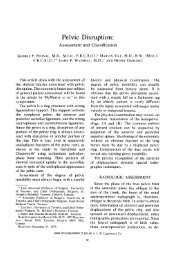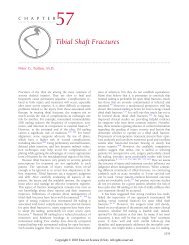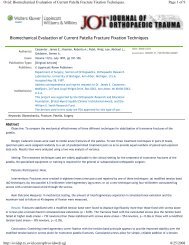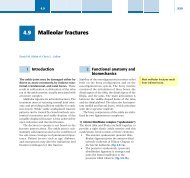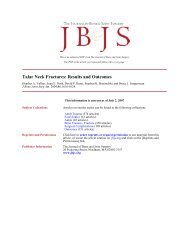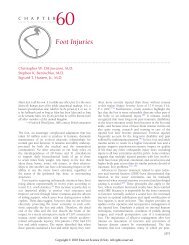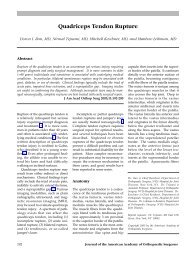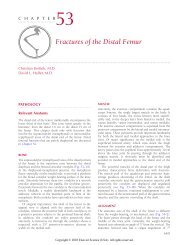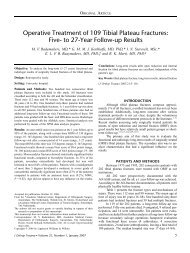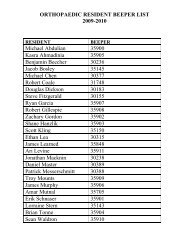Create successful ePaper yourself
Turn your PDF publications into a flip-book with our unique Google optimized e-Paper software.
<strong>4.7</strong><br />
483<br />
<strong>4.7</strong> <strong>Patella</strong><br />
Michael Nerlich & Bernhard Weigel<br />
1 Assessment of fractures<br />
and soft tissues<br />
1.1 Anatomy<br />
The patella is the largest sesamoid bone in the<br />
human body. It is located in the extensor apparatus<br />
of the knee. Anatomical features include<br />
the cranial base and the extra-articular caudal<br />
apex as well as the anterior extra-articular and<br />
the posterior articular surfaces. The rectus femoris<br />
and intermedius muscles insert at the<br />
base and the vastus medialis and lateralis muscles<br />
on either side. The patellar tendon originates<br />
from the apex patellae and inserts at the tibial<br />
tuberosity.<br />
1.2 History and examination<br />
<strong>Patella</strong>r fractures make up about 1% of all fractures<br />
[1] and are mostly caused by direct trauma<br />
to the front of the knee, for example, a fall from<br />
a height, a direct fall, or a blow, usually onto<br />
the flexed knee. Bony avulsions of the adjacent<br />
tendons are caused by indirect forces.<br />
Typical signs are swelling, tenderness, and<br />
limited or lost function, especially of the extensor<br />
mechanism. Preservation of active<br />
knee extension does not rule out a patellar<br />
fracture if “the auxiliary extensors of the<br />
knee” [2] are intact. If displacement is significant,<br />
the physician can palpate a defect between<br />
the fragments. Usually a hemarthrosis is<br />
present. The examination must include evaluation<br />
of the soft tissues, so as not to overlook<br />
an injury to the patellar bursa or to omit grading<br />
the injury if the fracture is open.<br />
1.3 X-ray evaluation<br />
In addition to the standard x-rays of the knee<br />
in two planes, a tangential view of the patella<br />
may be useful. In the AP view the patella normally<br />
projects into the midline of the femoral<br />
sulcus. Its apex is located just above a line drawn<br />
across the distal profile of femoral condyles. In<br />
the lateral view the proximal tibia must be<br />
visible to exclude a bony avulsion of the patellar<br />
ligament from the tibial tuberosity. A rupture<br />
of the patellar ligament or an abnormal position<br />
of the patella (patella alta, e.g., high-riding or<br />
patella baja, e.g., shortening of the tendon) can<br />
Preservation of active knee<br />
extension does not rule out a<br />
patellar fracture.
484 <strong>4.7</strong> <strong>Patella</strong>—M. Nerlich, B. Weigel<br />
45-A1 45-B1 45-C1<br />
Fig. <strong>4.7</strong>-1: Classification OTA<br />
Most types of fracture need<br />
open reduction and osteosynthesis.<br />
Patellectomy is reserved<br />
for fractures that cannot be<br />
reconstructed.<br />
be recognized with the help of the Insall method<br />
[3] of relating the greatest diagonal lengths<br />
of the patella and the patellar tendon. This ratio<br />
is normally r = 1. A ratio r < 1 suggests highriding<br />
patella (patella alta) or ligamentous<br />
rupture. The third important plane is the 30°<br />
tangential view, which is obtainable in 45° knee<br />
flexion. If a longitudinal or osteochondral fracture<br />
is suspected, the 30° tangential view will<br />
be a helpful diagnostic adjunct.<br />
Tomography is helpful in special cases, such<br />
as stress fractures, in elderly patients with osteopenia<br />
and hemarthrosis [4], and also in cases of<br />
a patellar non-union or malunion [5]. Computed<br />
tomography is recommended only for the<br />
evaluation of articular incongruity in cases of<br />
non-union, malunion, and femoropatellar alignment<br />
disorders. Scintigraphic examination can<br />
be helpful in the diagnosis of stress fractures;<br />
leukocyte scan can reveal signs of osteomyelitis<br />
[6].<br />
Tendon ruptures, patellar dislocation, and<br />
growth abnormalities (bipartite patella) must be<br />
ruled out. Isolated rupture of the quadriceps or<br />
patellar tendon must be excluded by clinical<br />
evaluation (palpation). The lateral x-ray may<br />
indicate an abnormal position of the patella.<br />
Dislocation, most commonly occurring to<br />
the lateral side, may result in osteochondral<br />
shear fractures with lesions of the medial margin<br />
of the patella.<br />
Bipartite or tripartite patella result from lack<br />
of assimilation of the bone during growth. Located<br />
on the proximal lateral quadrant of the patella, the<br />
condition is usually bilateral and has a characteristic<br />
x-ray feature with rounded, sclerotic lines<br />
rather than the sharp edges and lines of a fracture.<br />
1.4 Fracture classification<br />
The major fracture types are illustrated in<br />
Fig. <strong>4.7</strong>-1. Each fracture type has its own code<br />
consisting of three elements—e.g., 45-C1.3:<br />
The first element, 45, identifies the bone.<br />
The OTA classification describes the different<br />
fracture types:<br />
A Extra-articular, extensor mechanism<br />
disrupted: therapy operative.<br />
B Partial articular, extensor mechanism<br />
intact, for example, often vertical<br />
fractures: therapy non-operative or<br />
operative in case of intra-articular<br />
incongruency or danger of secondary<br />
dislocation.<br />
C Complete articular, disrupted extensor<br />
mechanism: therapy operative.<br />
1.5 Decision making<br />
The choice of treatment depends on the type of<br />
fracture (Fig. <strong>4.7</strong>-1). There are four possible<br />
treatment options.<br />
Non-operative treatment is generally possible<br />
in the case of closed, non-displaced fractures<br />
with an intact extensor mechanism (45-B).<br />
Simple fractures with gaps and steps in the<br />
articular surface may be stabilized by percutaneous<br />
screw fixation under arthroscopic control.<br />
Most types of fracture need open reduction<br />
and osteosynthesis.<br />
Patellectomy is reserved for fractures<br />
that cannot be reconstructed (45-C3). The<br />
recommended therapy for each fracture-pattern<br />
is included in the following Table <strong>4.7</strong>-1.
<strong>4.7</strong><br />
485<br />
Table <strong>4.7</strong>-1: Summary of indications<br />
45-A Extra-articular “pole” fractures<br />
• Lag screw plus tension band wire or cerclage<br />
to tuberosity<br />
• Transosseous suture of avulsed tendon plus<br />
cerclage between patella and tibial tuberosity<br />
to secure suture<br />
45-B Partial articular, vertical fracture<br />
• Non-displaced → Non-operative<br />
• Displaced, simple → Transverse lag screw,<br />
plus cerclage<br />
• Multifragmentary (stellate) → Circumferential<br />
cerclage plus tension band<br />
45-C Complete articular, transverse<br />
• K-wire plus tension band wire<br />
• Plus third fragment → Lag screw or K-wire<br />
plus tension band<br />
• Four or more fragments → K-wires, screws<br />
plus tension band<br />
• Partial or total patellectomy<br />
2 Surgical anatomy<br />
The anterior surface is surrounded by an extraosseous<br />
arterial ring, which receives inflow<br />
from branches of the genicular arteries. This<br />
anastomotic ring supplies the patella through<br />
midpatellar vessels, which penetrate the middle<br />
third of the anterior surface, and the polar<br />
vessels, which enter the apex [7, 8]. Avascular<br />
necrosis is rare but can occur when excessive<br />
bilateral incisions are made and the patella is<br />
injured.<br />
The infrapatellar branch of the saphenous<br />
nerve crosses from medial to the<br />
ventrolateral aspect of the tibial head<br />
close to the apex of the patella. It runs in<br />
the subcutaneous tissue layer and may be<br />
at risk in transverse incisions.<br />
2.1 Biomechanics<br />
(see chapter 3.2.3)<br />
The patella serves as the fulcrum of the extensor<br />
mechanism within the two lever arms, the<br />
quadriceps tendon as extension of the largest<br />
muscle in the body, and the patellar tendon<br />
inserting in the tibial tuberosity. Enormous<br />
forces are transmitted across the femoropatellar<br />
joint. Maximal forces measured within<br />
the quadriceps tendon ranged up to 3,200 N,<br />
within the patellar tendon 2,800 N, and in<br />
young, physically fit men up to 6,000 N [9]. This<br />
corresponds to three to seven times the<br />
body weight and indicates the load-bearing<br />
capacity required of an osteosynthesis. At 4–5<br />
mm in depth the patellar cartilage is the thickest<br />
in the human body [10]. This is due to the high<br />
pressures created by knee flexion and especially<br />
by arising from a squatting position. The shape<br />
of the femoropatellar joint, and hence the<br />
posterior surface of the patella, varies widely.<br />
<strong>Patella</strong>r tracking also depends on the configuration<br />
of the extensor mechanism and on the<br />
balance of the quadriceps muscles. The congruency<br />
of the articulation of the patella with<br />
the femur changes considerably from extension<br />
to flexion. From full extension to 45° of flexion the a-<br />
ticular surface of the patella is in contact with<br />
the anterior femur. In a knee flexed more than<br />
45° the posterior surface of the quadriceps<br />
Be aware of infrapatellar<br />
branch of saphenous nerve<br />
when using a transverse<br />
incision.<br />
Forces transmitted across the<br />
femoropatellar joint correspond<br />
to three to seven times the<br />
body weight.
486 <strong>4.7</strong> <strong>Patella</strong>—M. Nerlich, B. Weigel<br />
Due to the increased lever arm<br />
of the extensor mechanism an<br />
additional force is needed to<br />
gain full extension.<br />
The inflated tourniquet can<br />
inhibit the reduction of the<br />
fracture.<br />
tendon articulates with the patellar facets of the<br />
femur [10]. This increases the lever arm, for<br />
example, the distance from quadriceps tendonpatellar<br />
tendon linkage to the axis of knee<br />
rotation. The increased lever arm of the<br />
extensor mechanism, due to the height of<br />
the patella, adds an additional 60% of the<br />
force needed to gain full (e.g., the final 15°)<br />
extension [11]. This fact must be taken into<br />
account if patellectomy is performed, since full<br />
extension power will be markedly reduced<br />
postoperatively.<br />
3 Preoperative planning<br />
3.1 Positioning and<br />
approaches<br />
The patient is placed supine on a radiolucent<br />
table. A cushion under the patient’s ipsilateral<br />
buttock is helpful to rotate the leg internally. A<br />
tourniquet around the thigh, inflated to about<br />
250 mmHg, gives better visibility. The surgeon<br />
has to take into account that the inflated tourniquet<br />
can complicate the reduction of the<br />
fracture by fixing the quadriceps in a shortened<br />
position. To avoid this, the knee should<br />
be carefully flexed beyond 90° and the patella<br />
manually pushed distally to gain as much length<br />
as necessary before the tourniquet is inflated<br />
[6]. In some cases it may be helpful to deflate<br />
the tourniquet while reducing the fracture.<br />
Clinical examination under anesthesia<br />
Clinical examination of the knee under anesthesia<br />
is of the utmost importance. Associated<br />
lesions, such as ligamentous damage or dislocation<br />
and instability, must be ruled out.<br />
Approach<br />
Either a longitudinal or a transverse incision can<br />
be used (Fig. <strong>4.7</strong>-2). We prefer the midline longitudinal<br />
incision over the patella, because it can<br />
be extended proximally or distally and it does<br />
not interfere in case of later revision. The transverse<br />
approach gives the best cosmetic result<br />
since it lies within Langer’s lines, but may injure<br />
the infrapatellar branch of the saphenous nerve.<br />
Parapatellar incisions are also possible, especially<br />
in the case of an open fracture when one<br />
may be able to incorporate skin lesions into the<br />
approach. After incision of the superficial fascia,<br />
the extensor apparatus is exposed and tears in<br />
the auxiliary extensors can be identified. If<br />
necessary to inspect the knee joint, a medial<br />
parapatellar arthrotomy is made. Intra-articular<br />
surgery can be performed as needed. In the case<br />
of an open fracture or a pre-existing chronic<br />
bursitis, the prepatellar bursa may be excised;<br />
this is normally not required in closed fractures.<br />
3.2 Reduction techniques<br />
and tools<br />
The knee joint and fracture lines must be irrigated<br />
and cleared of small debris to allow exact<br />
reconstruction. The larger fragments are reduced<br />
using a large pointed bone reduction<br />
forceps. In type A or C fractures, reduction is<br />
easier in a full or hyperextended position of the<br />
knee. Longitudinal type B fractures are sometimes<br />
better reduced with the knee flexed. Anatomical<br />
reduction of the articular surface is<br />
monitored by palpating the joint from inside,<br />
as neither inspection nor the x-ray will reveal<br />
a minor step off. If an inside-out technique is<br />
planned, K-wires are inserted in an open manner<br />
before the reduction is done. The wires can also
<strong>4.7</strong><br />
487<br />
tension band except in longitudinal type B fractures.<br />
Articular osteochondral flake fractures<br />
can be kept in place with biodegradable pins<br />
until healed.<br />
1<br />
Tension band wiring<br />
a) b)<br />
Fig. <strong>4.7</strong>-2: Skin incisions/approaches.<br />
a) Midline/vertical: allows for extensions and respects infrapatellar<br />
nerve (1). A parapatellar incision is also possible.<br />
b) Transverse: respects Langer’s line and allows easy<br />
access laterally and medially. Usually severs infrapatellar<br />
nerve (1). Choice of approach should respect the skin<br />
contusion/abrasion which is often present.<br />
be used as joysticks to help in reducing the<br />
fragments. Reduction is held by one or two<br />
reduction forceps.<br />
3.3 Choice of implant<br />
The forces being transmitted through the<br />
patella require implants that withstand<br />
high tensile stress. Tension band wiring, being<br />
highly effective in transforming distraction forces<br />
into compressing forces, is most widely used.<br />
Single lag screws, if applied properly, will add<br />
to stability but should not be used without a<br />
1.0 mm or, exceptionally, 1.25 mm stainless steel<br />
wire in combination with 1.6, 1.8, or 2.0 mm<br />
K-wires are the implants of choice.<br />
Lag screws<br />
The small fragment 3.5 mm cortex screw, used<br />
as a lag screw, is preferred. The 4.0 mm cancellous<br />
bone screw can also be used, but it has<br />
some disadvantages. Because of the high density<br />
of the patellar bone, reduction may be lost<br />
during screw insertion (high torque). Removal<br />
of a shaft screw may be difficult.<br />
Biodegradable implants<br />
Osteochondral fragments can be fixed with<br />
biodegradable pins of 1.6–2.0 mm diameter<br />
instead of K-wires. These implants consist of<br />
polyglycolic acid (PGA), polydioxanone (PDS),<br />
or polylactic acid (PLA). PGA starts to lose stability<br />
after 1–2 weeks; while PLA holds for 6<br />
months. These implants are useful only for<br />
adaptation of unloaded fragments and are not<br />
recommended in areas of high mechanical<br />
stress. The same applies to resorbable suture<br />
material, which cannot match the tensile<br />
strength of metallic wires. Different factors<br />
contribute to the biocompatibility of these implants,<br />
and local foreign-body reactions remain<br />
a matter of concern [12]. Their advantage is that<br />
implant removal can be avoided.<br />
The patella requires implants<br />
that withstand high tensile<br />
stress.
488 <strong>4.7</strong> <strong>Patella</strong>—M. Nerlich, B. Weigel<br />
4 Surgical treatment—<br />
tricks and hints<br />
4.1 Open fractures<br />
Débridement of contused or<br />
contaminated soft tissue is<br />
essential in open fractures.<br />
Tension band principle: Tensile<br />
forces are converted to compression.<br />
Open fractures are generally emergency cases<br />
and require surgery as soon as possible. Débridement<br />
of contused or contaminated<br />
soft tissue should be combined with irrigation<br />
or in severe cases with jet lavage.<br />
Soft-tissue stripping from the bony fragments<br />
must be avoided for the sake of maintaining<br />
blood supply (see chapter 5.1).<br />
Procedure<br />
First, the complete extent of the injury must be<br />
identified, since the preoperative x-ray may not<br />
always reveal all fracture lines. Any extra-articular<br />
fracture lines will be detected by clearing<br />
a very small amount of overlapping tissue (1 or<br />
2 mm) at the fracture edges. Steps, gaps, and<br />
the amount of destroyed or impacted cartilage<br />
are noted and any loose fragments are removed<br />
from the knee. The joint is irrigated and the<br />
articular surface of the corresponding femoral<br />
condyle is examined.<br />
4.2 Tension band wiring<br />
The principle is to convert the tension<br />
force into compression as the knee is flexed<br />
(Fig. <strong>4.7</strong>-3) (Video AO51049).<br />
Reduction and fixation can be achieved in two<br />
ways, either by first reducing the fracture and<br />
then drilling the K-wires through the reduced<br />
fragments (outside-in technique) or by first<br />
drilling the wires into the unreduced fragments<br />
Video AO51049<br />
followed by reduction and completion of the<br />
fixation (inside-out technique).<br />
Using the outside-in technique, the first wire<br />
is drilled in an axial direction, the second one<br />
parallel to the first, through the reduced fragments.<br />
It may be difficult to find the right direction<br />
and position for the wires. Alternatively,<br />
drilling the two wires from the fracture side<br />
inside out should be considered. Before reduction,<br />
the blunt ends of the wires must be cut<br />
obliquely, to make them pointed. After this, the<br />
main fragments will be manually reduced and<br />
held with a pointed reduction forceps. Then the<br />
K-wires are drilled forward through the opposite<br />
main fragment. (If the bone is very dense, the<br />
holes for the K-wires can be predrilled.) The ideal<br />
level for the pins lies in the center of the patella,<br />
approximately 5 mm below its anterior surface.<br />
Often the K-wires are closer to the articular<br />
than to the anterior surface. Nevertheless, the<br />
principle of tension banding is not disturbed.<br />
A sufficiently long (ca. 30 cm), 1.0 or 1.25 mm<br />
thick cerclage wire is pushed manually as closely<br />
as possible to the edge between the bone and<br />
the protruding pin tips. The cerclage is placed
<strong>4.7</strong><br />
489<br />
Fig. <strong>4.7</strong>-3:<br />
a) 45-C transverse fracture.<br />
b) Reduction with large reduction<br />
forceps with points and preliminary<br />
fixation with two parallel<br />
1.6–2.0 mm K-wires.<br />
c) To pass the “cerclage” wires<br />
through the ligamentous<br />
structures and around the<br />
K-wires close to the bone it may<br />
be helpful to use a curved large<br />
bore needle or cannula.<br />
d) The cerclage wire should lie<br />
anteriorly to the patella so as to<br />
act as a tension band. A circular<br />
wire is preferable to a figure-ofeight.<br />
a) b)<br />
45-C<br />
e) The lateral view demonstrates<br />
the tension band principle,<br />
where by flexing the knee,<br />
tensile forces are converted into<br />
compressive ones (arrows).<br />
c) d) e)
490 <strong>4.7</strong> <strong>Patella</strong>—M. Nerlich, B. Weigel<br />
in the form of a figure-of-zero or figure-of-eight.<br />
The wire should be as close as possible to the<br />
bone throughout its whole course. The use of<br />
a curved large bore injection needle may be<br />
helpful (Fig. <strong>4.7</strong>-3c). The figure-of-zero of the<br />
cerclage has more stability against torsion forces,<br />
but if the pins are located near the bone limits,<br />
the cerclage can cut into the retinacula. As a<br />
result the principle of tension banding might be<br />
lost. A figure-of-eight is therefore preferred by<br />
some authors, although it does “squeeze” the<br />
underlying tissues. The ends of the cerclage are<br />
located medially or laterally.<br />
While tightening the cerclage with the knee<br />
in extension, the reduction is checked by palpating<br />
the retropatellar surface. After tightening<br />
the cerclage, the proximal pin ends will be bent,<br />
shortened and turned towards the quadriceps<br />
tendon, and driven into the patella to prevent<br />
skin irritation and loosening. The distal pin ends<br />
are only trimmed, not bent, for easier removal.<br />
Additional cerclage<br />
Even comminuted fractures can be reduced and<br />
stabilized with the tension band technique<br />
if they are not too badly displaced (type B3<br />
stellate fracture) (Fig. <strong>4.7</strong>-4). In such cases, with<br />
many small fragments, the tension band technique<br />
must be combined with an additional<br />
circumferential cerclage around the fractured<br />
patella. The placement of this cerclage should<br />
be the initial step of stabilization to avoid further<br />
displacement as tension band wiring is carried<br />
out.<br />
45-B3<br />
b) In the second step<br />
add the vertical K-wires<br />
and the standard<br />
anterior tension band<br />
configuration.<br />
Fig. <strong>4.7</strong>-4: a) Relatively<br />
non-displaced stellate<br />
(45-B3) fracture. In the<br />
first step a circumferential<br />
1 mm cerclage<br />
wire is placed around<br />
the “equator” of the<br />
patella.
<strong>4.7</strong><br />
491<br />
Combined tension banding plus lag screws<br />
or K-wires<br />
In transverse fractures, the two main fragments<br />
are themselves often further fragmented<br />
(Fig. <strong>4.7</strong>-5). Tension band wiring is possible only<br />
if the two main fragments have been reconstructed<br />
by lag screws. After reduction of fragments<br />
and temporary fixation by a pointed<br />
reduction forceps, the screws are implanted as<br />
demonstrated in chapter 3.2.1. Lag screws are<br />
inserted closer to the retropatellar surface leaving<br />
enough space for the K-wires. For fragments<br />
too small to hold a screw, 1.6 mm K-wires are<br />
used. Interfragmentary compression is done<br />
later by an additional cerclage.<br />
45-B2.2<br />
Fig. <strong>4.7</strong>-5: 45-C2.2 fracture.<br />
A combination of a transverse<br />
4.0 mm lag screw with the<br />
standard tension band (see<br />
Fig. <strong>4.7</strong>-3) is used to fix the<br />
transverse and vertical fracture<br />
pattern.<br />
Lag screws plus an anterior band wiring<br />
Fractures of a pole of the patella are best stabilized<br />
by lag screws (Fig. <strong>4.7</strong>-6). As implant pullout<br />
or failure is inevitable, the bending<br />
forces must be neutralized by additional anterior<br />
tension band wiring. Upper pole fractures<br />
are stabilized in this manner, if necessary combined<br />
with additional transosseous sutures of<br />
the quadriceps tendon.<br />
Transosseous sutures for tendon repair<br />
Very small fragments should be excised and<br />
tendon repair is done by transosseous sutures<br />
alone (Fig. <strong>4.7</strong>-6a). We prefer non-resorbable<br />
heavy suture material for the main adaptation<br />
and resorbable material for the additional fine<br />
sutures.
492 <strong>4.7</strong> <strong>Patella</strong>—M. Nerlich, B. Weigel<br />
a) 45-A<br />
b)<br />
Fig. <strong>4.7</strong>-6: 45-A fracture with avulsion of the<br />
lower pole of the patella. To anchor the wire<br />
in the tibial tuberosity a screw is used as<br />
shown or the wire is pushed through a<br />
cannulated screw.<br />
a) The fragment is discarded and the transosseous sutures reattaching<br />
the patellar ligament are protected by a figure-of-eight wire between<br />
patella and tibial tuberosity.<br />
b) The fragment is preserved and fixed with a 4.0 mm cancellous bone<br />
screw. Again, this must be protected by a figure-of-eight wire.<br />
Partial patellectomy is preferred<br />
to total patellectomy.<br />
4.3 Patellotibial cerclage<br />
Management is the same as for lower pole fractures,<br />
but if fixation of patellar tendon origin is<br />
inadequate because of a small fragment or multiple<br />
parts, the necessary transosseous sutures<br />
must be protected by a patellotibial cerclage<br />
between patella and tibial tuberosity (Fig. <strong>4.7</strong>-6b).<br />
The anchoring at the tuberosity can occur<br />
around a 3.5 mm cortex screw or through the<br />
hole of a cannulated screw. When tightening<br />
this, it is necessary to ensure that the knee can<br />
flex to 90°. This means that in full extension<br />
there will be some redundancy of the cerclage<br />
wire.<br />
4.4 Partial patellectomy<br />
Partial patellectomy is preferred to<br />
total patellectomy, whenever possible, as<br />
it keeps the lever arm intact (Fig. <strong>4.7</strong>-7).<br />
A comminuted upper or lower pole and even<br />
a comminuted zone in the middle of the patella<br />
can be managed best by taking out all small<br />
particles. If the damaged zone is in the middle<br />
of the patella, an osteotomy proximally as well<br />
as distally and reduction of the main fragments,<br />
as in a transverse fracture, can be done. If the<br />
comminuted area is marginal, the bony particles<br />
should be removed in order to prevent osteophyte<br />
formation. Then the neighboring tendon
<strong>4.7</strong><br />
493<br />
part is sutured keeping the extensor<br />
axis in mind, otherwise patellar<br />
balance could be disturbed. Distally,<br />
sutures have to be protected by<br />
a patellotibial cerclage as described<br />
above.<br />
4.5 Patellectomy<br />
45-C3<br />
In case of severe comminution and<br />
extended cartilage damage, patellectomy<br />
may be the only way to manage<br />
the injury (Fig. <strong>4.7</strong>-8). All bony fragments<br />
and shredded tissue are removed<br />
by sharp dissection leaving as much<br />
extensor apparatus as possible. Tendinous<br />
reconstruction then follows. A<br />
defect zone of 3–4 cm can be bridged<br />
by direct adaptation. Shortening of<br />
the extensor apparatus is beneficial as<br />
it increases the muscle preload. If a<br />
direct suture proves impossible, then<br />
inverted V-plasty is recommended [6].<br />
However, one should always take into<br />
consideration the fact that retention<br />
of even one larger fragment would<br />
maintain the lever arm.<br />
Wound closure<br />
Fig. <strong>4.7</strong>-7: In the case of a severe central comminution of the<br />
patella, as a salvage procedure the injured segment may be<br />
removed by osteotomy. The two remaining portions are<br />
joined together by two lag screws and a tension band wire.<br />
A suction drain is placed into the joint.<br />
The arthrotomy is closed and tears in<br />
the retinacula are adapted by resorbable<br />
sutures and the skin is closed. In<br />
open fractures the small implants can<br />
usually be covered by adjacent soft<br />
tissue and the skin can be mobilized<br />
considerably, so even large skin defects<br />
do not pose any problem.
494 <strong>4.7</strong> <strong>Patella</strong>—M. Nerlich, B. Weigel<br />
Fig. <strong>4.7</strong>-8:<br />
45-C closed fracture.<br />
a) Closed fracture of<br />
the patella.<br />
b) After ORIF with<br />
tension band wiring.
<strong>4.7</strong><br />
495<br />
5 Postoperative treatment<br />
The osteosynthesis is stable and implants (not<br />
only K-wires but also lag screws) are protected<br />
by anterior banding against bending forces.<br />
Therefore, it may not be necessary to use casts<br />
or braces. When the patient is walking, a knee<br />
brace is helpful until quadriceps control is<br />
regained. Early motion, especially active assisted,<br />
is beneficial to articular cartilage health. This<br />
may be facilitated by continuous passive motion<br />
(CPM). Drains are removed on the first<br />
or second postoperative day, depending on the<br />
amount of wound drainage. Then the patient<br />
begins with isometric exercises and mobilization.<br />
Partial weight bearing to 15 kg or half<br />
body weight for 6 weeks and active assisted<br />
motion from full extension to 90° of knee flexion<br />
are allowed, assuming there are no wound<br />
problems. Knee flexion is most important for<br />
changing anterior traction forces into retropatellar<br />
compression forces, which supports<br />
bone healing.<br />
Implant removal will take place after 1 year<br />
on average (6–24 months). A patellotibial cerclage<br />
should be removed within 12 weeks if 90°<br />
knee flexion is not obtained or after breakage<br />
if painful.<br />
6 Pitfalls and<br />
complications<br />
Disturbed wound healing<br />
The optimal plane of tissue dissection lies<br />
between the subcutaneous fascia and the<br />
extensor apparatus. For an undisturbed blood<br />
supply of the skin, it is very important not to<br />
commit the common error of separating the<br />
tissue layers between skin and subcutaneous<br />
fascia. The inevitable result will be the necrosis<br />
of the wound margins. Improper use of wound<br />
hooks can also produce such problems.<br />
Deep infection<br />
Revision with débridement and irrigation is<br />
indicated every other day until wound healing<br />
is secured. With deep infection, long-term antibiotic<br />
application (6 weeks) is recommended<br />
(see chapter 5.5).<br />
Synovitis by biodegradable implants<br />
Crystalline decomposition products can create<br />
mild to severe sterile synovitis, which may be<br />
hard to distinguish from an infection. An<br />
arthroscopic intervention may be necessary [12].<br />
Skin irritation by wire tips<br />
The irritating end of a pin or a cerclage<br />
should be shortened before the soft-tissue<br />
layer becomes perforated; otherwise the<br />
patient is threatened with infection.<br />
<strong>Patella</strong> baja<br />
This complication can cause a severe limitation<br />
of knee flexion. If there is the need for a cerclage<br />
wire to protect the patellar ligament, a<br />
patella baja could be produced by misjudging<br />
the exact length of the patellar tendon. The<br />
opposite knee will indicate the correct position<br />
of the patella as described under x-ray evaluation.<br />
Shorten ends of pin and<br />
cerclage before soft tissue is<br />
perforated.<br />
The optimal plane of tissue<br />
dissection lies between the<br />
subcutaneous fascia and the<br />
extensor apparatus.
496 <strong>4.7</strong> <strong>Patella</strong>—M. Nerlich, B. Weigel<br />
Implant failure<br />
Implant failure requires a revision only if the<br />
main fragments are displaced or the articular<br />
surface is showing incongruity. A common<br />
complication is proximal K-wire migration. To<br />
prevent this, the wire ends should be bent to a<br />
loop and the tension band wire is then pulled<br />
through the two proximal loops holding the<br />
K-wires in stable position [13]. A rare complication<br />
is the intra-articular migration of a<br />
broken wire [14].<br />
Loss of motion<br />
In the case of limited flexion, intensive physiotherapy<br />
is indicated. If the range of motion does<br />
not improve within months, an arthroscopic<br />
arthrolysis will be the next step, removing scar<br />
contractions from the upper recess. If patellectomy<br />
has been performed, tendon rupture is<br />
a later possibility.<br />
Posttraumatic arthritis<br />
This can follow if the patellar ligament is attached<br />
too anteriorly, rotating the distal pole backwards,<br />
or if the patella becomes elongated as a<br />
comminuted fracture heals. In the first situation<br />
the origin of the tendon should be corrected by<br />
transposing it, in the second case patellectomy<br />
is indicated.<br />
7 Bibliography<br />
1. Bostrom A (1972) Fracture of the<br />
patella. A study of 422 patellar fractures.<br />
Acta Orthop Scand Suppl; 143:1–80.<br />
2. Carson WG, Jr., James SL, Larson RL,<br />
et al. (1984) Patellofemoral disorders:<br />
physical and radiographic evaluation. Part<br />
II: Radiographic examination. Clin Orthop;<br />
(185):178–186.<br />
3. Insall JN (1984) Anatomy of the knee.<br />
Surgery of the Knee. New York: Churchill-<br />
Livingstone: 1–20.<br />
4. Weber BG, Cech O (1976) Pseudarthrosis.<br />
New York: Grune & Stratton: 224–225.<br />
5. Sanders R (1992) <strong>Patella</strong> fractures and<br />
extensor mechanism injuries. In:<br />
Browner BD, Jupiter JB, Levine AM, et<br />
al., editors. Skeletal Trauma. Philadelphia:<br />
W. B. Saunders Co.: 1685–1710.<br />
6. Arnoczky SP (1985) Blood supply to the<br />
anterior cruciate ligament and supporting<br />
structures. Orthop Clin North Am;<br />
16 (1):15–28.<br />
7. Scapinelli R (1967) Blood supply of the<br />
human patella. Its relation to ischaemic<br />
necrosis after fracture. J Bone Joint Surg [Br];<br />
49 (3):563–570.<br />
8. Huberti HH, Hayes WC, Stone JL,<br />
et al. (1984) Force ratios in the<br />
quadriceps tendon and ligamentum<br />
patellae. J Orthop Res; 2 (1):49–54.<br />
9. Kapandji IA (1985) Funktionelle<br />
Anatomie der Gelenke. Stuttgart:<br />
Enke Verlag.<br />
10. Goodfellow J, Hungerford DS, Zindel M<br />
(1976) Patello-femoral joint mechanics<br />
and pathology 1. Functional anatomy of<br />
the patello-femoral joint. J Bone Joint Surg<br />
[Br]; 58 (3):287–299.
<strong>4.7</strong><br />
497<br />
11. Hoffmann R, Weller A, Helling HJ,<br />
et al. (1997) [Local foreign body<br />
reactions to biodegradable implants. A<br />
classification]. Unfallchirurg;<br />
100 (8):658–666.<br />
12. Gotzen L, Ishaque B, Morgenthal F,<br />
et al. (1997) [External patello-tibial<br />
transfixation. I: Indications and<br />
technique]. Unfallchirurg; 100 (1):24–28.<br />
13. Us AK, Kinik H (1966) Self locking<br />
tension band technique in transverse<br />
patellar fractures. Int Orthop; 20:357–358.<br />
14. Chen YJ, Wu CC, Hsu RW, et al. (1994)<br />
The intra-articular migration of the<br />
broken wire: a rare complication of<br />
circumferential wiring in patellar<br />
fractures. Chang Keng I Hsueh Tsa Chih;<br />
17 (3):276–279.<br />
8 Updates<br />
Updates and additional references for this chapter<br />
are available online at:<br />
http://www.aopublishing.org/PFxM/<strong>4.7</strong>.htm



